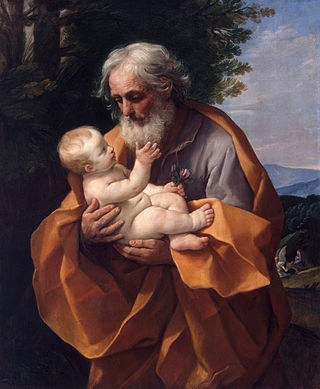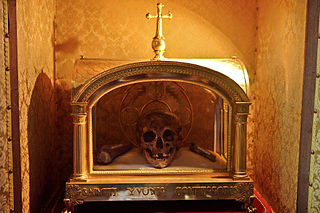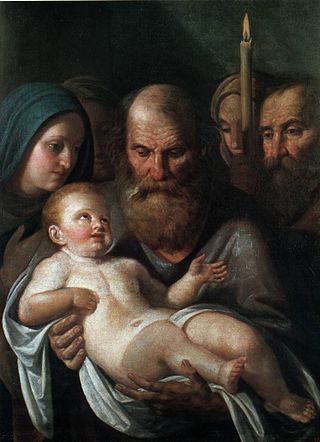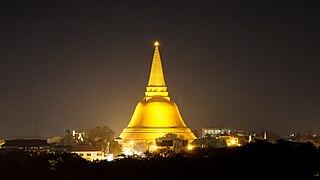
In religious belief, a saint is a person who is recognized as having an exceptional degree of holiness, likeness, or closeness to God. However, the use of the term saint depends on the context and denomination. In Catholic, Eastern Orthodox, Anglican, Oriental Orthodox, and Lutheran doctrine, all of their faithful deceased in Heaven are considered to be saints, but some are considered worthy of greater honor or emulation. Official ecclesiastical recognition, and consequently a public cult of veneration, is conferred on some denominational saints through the process of canonization in the Catholic Church or glorification in the Eastern Orthodox Church after their approval.

An altar is a table or platform for the presentation of religious offerings, for sacrifices, or for other ritualistic purposes. Altars are found at shrines, temples, churches, and other places of worship. They are used particularly in paganism, Christianity, Buddhism, Hinduism, Judaism, modern paganism, and in certain Islamic communities around Caucasia and Asia Minor. Many historical-medieval faiths also made use of them, including the Roman, Greek, and Norse religions.

Saint Joseph's Day, also called the Feast of Saint Joseph or the Solemnity of Saint Joseph, is in Western Christianity the principal feast day of Saint Joseph, husband of the Virgin Mary and legal father of Jesus Christ, celebrated on 19 March. It has the rank of a solemnity in the Catholic Church. It is a feast or commemoration in the provinces of the Anglican Communion, and a feast or festival in the Lutheran Church. Saint Joseph's Day is the Patronal Feast day for Poland as well as for Canada, persons named Joseph, Josephine, etc., for religious institutes, schools and parishes bearing his name, and for carpenters. It is also Father's Day in some Catholic countries, mainly Spain, Portugal, and Italy. It is not a holy day of obligation for Catholics in the United States.

The Holy Lance, also known as the Lance of Longinus, the Spear of Destiny, or the Holy Spear, is the lance that is alleged to have pierced the side of Jesus as he hung on the cross during his crucifixion.

Veneration, or veneration of saints, is the act of honoring a saint, a person who has been identified as having a high degree of sanctity or holiness. Angels are shown similar veneration in many religions. Veneration of saints is practiced, formally or informally, by adherents of some branches of all major religions, including Christianity, Judaism, Hinduism, Islam, Buddhism and Jainism.

In religion, a relic is an object or article of religious significance from the past. It usually consists of the physical remains or personal effects of a saint or other person preserved for the purpose of veneration as a tangible memorial. Relics are an important aspect of some forms of Buddhism, Christianity, Islam, shamanism, and many other religions. Relic derives from the Latin reliquiae, meaning "remains", and a form of the Latin verb relinquere, to "leave behind, or abandon". A reliquary is a shrine that houses one or more religious relics.

The True Cross is a term used for the cross upon which Jesus was said to have been crucified, particularly as an object of religious veneration. There are no early accounts that the apostles or early Christians preserved the physical cross themselves, although protective use of the sign of the cross was common by at least the 2nd century. Post-Nicene historians such as Socrates of Constantinople relate that Helena, the mother of the Roman emperor Constantine I, travelled to the Holy Land in the years 326–328, founding churches and establishing relief agencies for the poor. The late 4th-century historians Gelasius of Caesarea and Tyrannius Rufinus claimed that while there she discovered the hiding place of three crosses that were believed to have been used at the crucifixion of Jesus and the two thieves, St. Dismas and Gestas, executed with him. To one cross was affixed the titulus bearing Jesus's name, but according to Rufinus, Helena was not sure until a miracle revealed that this was the True Cross.
A number of alleged relics associated with Jesus have been displayed throughout the history of Christianity. While some individuals believe in the authenticity of Jesus relics, others doubt their validity. For instance, the sixteenth-century philosopher Erasmus wrote about the proliferation of relics, and the number of buildings that could be constructed from wooden relics claimed to be from the crucifixion cross of Jesus. Similarly, at least thirty Holy Nails were venerated as relics across Europe in the early 20th century. Part of the relics are included in the so-called Arma Christi, or the Instruments of the Passion.

According to the New Testament, a woven crown of thorns was placed on the head of Jesus during the events leading up to his crucifixion. It was one of the instruments of the Passion, employed by Jesus' captors both to cause him pain and to mock his claim of authority. It is mentioned in the gospels of Matthew, Mark and John, and is often alluded to by the early Church Fathers, such as Clement of Alexandria, Origen and others, along with being referenced in the apocryphal Gospel of Peter.

A reliquary is a container for relics. A portable reliquary may be called a fereter, and a chapel in which it is housed a feretory.

Simeon at the Temple is the "just and devout" man of Jerusalem who, according to Luke 2:25–35, met Mary, Joseph, and Jesus as they entered the Temple to fulfill the requirements of the Law of Moses on the 40th day from Jesus' birth, i. e. the presentation of Jesus at the Temple.

San Thome Church, officially known as St Thomas Cathedral Basilica and National Shrine of Saint Thomas, is a minor basilica of the Catholic Church in India, at the Santhome neighbourhood of Chennai, in Tamil Nadu. The present structure dates to 1523 AD, when it was rebuilt by the Portuguese over the tomb of Thomas the Apostle. In 1896, it was renovated in the Madras province according to neo-Gothic designs, as was favoured by British architects in the late 19th century. It is one of the only three churches of the apostolic age of ancient Christianity, known for enshrining the tomb of an apostle and are still standing in the world today; the other two being the St Peter's Basilica in Vatican City and Santiago de Compostela Cathedral in Galicia, Spain. In antiquity, there was a basilica built over the tomb of the Apostle Philip in Hierapolis of Phrygia, present-day Pamukkale.

Catholic devotions are particular customs, rituals, and practices of worship of God or honour of the saints which are in addition to the liturgy of the Catholic Church. The United States Conference of Catholic Bishops describes devotions as "expressions of love and fidelity that arise from the intersection of one's own faith, culture and the Gospel of Jesus Christ". Devotions are not considered part of liturgical worship, even if they are performed in a church or led by a priest, but rather they are paraliturgical. The Congregation for Divine Worship at the Vatican publishes a Directory on Popular Piety and the Liturgy.
A lampadarius, plural Lampadarii, from the Latin lampada, from Ancient Greek "lampas" λαμπάς (candle), was a slave who carried torches before consuls, emperors and other officials of high dignity both during the later Roman Republic and under the Empire. Lampadarios in the post-Byzantine period designates the leader of the second (left) choir of singers in the Eastern Orthodox church practice.

The Saint Benedict Medal is a Christian sacramental medal containing symbols and text related to the life of Saint Benedict of Nursia, used by Roman Catholics, Lutherans, Western Orthodox, Anglicans and Methodists, in the Benedictine Christian tradition, especially votarists and oblates.

In Christianity, the translation of relics is the removal of holy objects from one locality to another ; usually only the movement of the remains of the saint's body would be treated so formally, with secondary relics such as items of clothing treated with less ceremony. Translations could be accompanied by many acts, including all-night vigils and processions, often involving entire communities.

The Basilica of the Holy Blood is a Roman Catholic basilica in Bruges, Belgium. The church houses a relic of the Holy Blood allegedly collected by Joseph of Arimathea and brought from the Holy Land by Thierry of Alsace, Count of Flanders. Built between 1134 and 1157 as the chapel of the Count of Flanders, it was promoted to a minor basilica in 1923.

Cetiya, "reminders" or "memorials", are objects and places used by Buddhists to remember Gautama Buddha. According to Damrong Rajanubhab, four kinds are distinguished in the Pāli Canon: "Relic [Dhatu], Memorial [Paribhoga], Teaching [Dhamma], and votive [Udesaka]." Griswold, in contrast, states that three are traditional and the fourth, the Buddha Dhamma, was added later to remind monks that the true memory of Gautama Buddha can be found in his teachings. While these can be broadly called Buddhist symbolism, the emphasis tends to be on a historical connection to the Buddha and not a metaphysical one.

The Parish Church of the Assumption of the Blessed Virgin Mary into Heaven is a Roman Catholic parish church in Żebbuġ, Gozo, Malta, dedicated to the Assumption of Mary. The present building was built between 1690 and 1726 on the site of an earlier church, and it was enlarged between 1938 and 1942. The church's interior was extensively decorated using locally-sourced travertine from cave deposits in the late 20th century.

The Pilgrimage of the Relics or Maastricht Septennial Pilgrimage is a seven-yearly Catholic event in the Dutch city of Maastricht. Originating in the Middle Ages, it developed from a pilgrimage to the grave of Saint Servatius into the present-day religious, historical, cultural and commercial enterprise. Highlights in the programme are the displaying or unveiling of the relics in the main churches and secondly, the processions with the town's main relics. The next pilgrimage will take place in 2025.


















